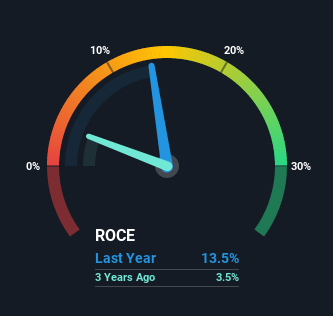- Hong Kong
- /
- Metals and Mining
- /
- SEHK:1053
Chongqing Iron & Steel (HKG:1053) Is Looking To Continue Growing Its Returns On Capital

There are a few key trends to look for if we want to identify the next multi-bagger. Amongst other things, we'll want to see two things; firstly, a growing return on capital employed (ROCE) and secondly, an expansion in the company's amount of capital employed. Put simply, these types of businesses are compounding machines, meaning they are continually reinvesting their earnings at ever-higher rates of return. Speaking of which, we noticed some great changes in Chongqing Iron & Steel's (HKG:1053) returns on capital, so let's have a look.
Understanding Return On Capital Employed (ROCE)
If you haven't worked with ROCE before, it measures the 'return' (pre-tax profit) a company generates from capital employed in its business. Analysts use this formula to calculate it for Chongqing Iron & Steel:
Return on Capital Employed = Earnings Before Interest and Tax (EBIT) ÷ (Total Assets - Current Liabilities)
0.14 = CN¥3.8b ÷ (CN¥42b - CN¥13b) (Based on the trailing twelve months to September 2021).
Thus, Chongqing Iron & Steel has an ROCE of 14%. That's a relatively normal return on capital, and it's around the 13% generated by the Metals and Mining industry.
Check out our latest analysis for Chongqing Iron & Steel

While the past is not representative of the future, it can be helpful to know how a company has performed historically, which is why we have this chart above. If you want to delve into the historical earnings, revenue and cash flow of Chongqing Iron & Steel, check out these free graphs here.
How Are Returns Trending?
The fact that Chongqing Iron & Steel is now generating some pre-tax profits from its prior investments is very encouraging. The company was generating losses five years ago, but now it's earning 14% which is a sight for sore eyes. Not only that, but the company is utilizing 122% more capital than before, but that's to be expected from a company trying to break into profitability. This can tell us that the company has plenty of reinvestment opportunities that are able to generate higher returns.
In another part of our analysis, we noticed that the company's ratio of current liabilities to total assets decreased to 32%, which broadly means the business is relying less on its suppliers or short-term creditors to fund its operations. This tells us that Chongqing Iron & Steel has grown its returns without a reliance on increasing their current liabilities, which we're very happy with.
The Key Takeaway
Long story short, we're delighted to see that Chongqing Iron & Steel's reinvestment activities have paid off and the company is now profitable. Astute investors may have an opportunity here because the stock has declined 46% in the last five years. With that in mind, we believe the promising trends warrant this stock for further investigation.
On a final note, we've found 1 warning sign for Chongqing Iron & Steel that we think you should be aware of.
For those who like to invest in solid companies, check out this free list of companies with solid balance sheets and high returns on equity.
New: AI Stock Screener & Alerts
Our new AI Stock Screener scans the market every day to uncover opportunities.
• Dividend Powerhouses (3%+ Yield)
• Undervalued Small Caps with Insider Buying
• High growth Tech and AI Companies
Or build your own from over 50 metrics.
Have feedback on this article? Concerned about the content? Get in touch with us directly. Alternatively, email editorial-team (at) simplywallst.com.
This article by Simply Wall St is general in nature. We provide commentary based on historical data and analyst forecasts only using an unbiased methodology and our articles are not intended to be financial advice. It does not constitute a recommendation to buy or sell any stock, and does not take account of your objectives, or your financial situation. We aim to bring you long-term focused analysis driven by fundamental data. Note that our analysis may not factor in the latest price-sensitive company announcements or qualitative material. Simply Wall St has no position in any stocks mentioned.
About SEHK:1053
Chongqing Iron & Steel
Engages in the production and sale of steel plates in the People’s Republic of China.
Undervalued with adequate balance sheet.
Market Insights
Community Narratives





